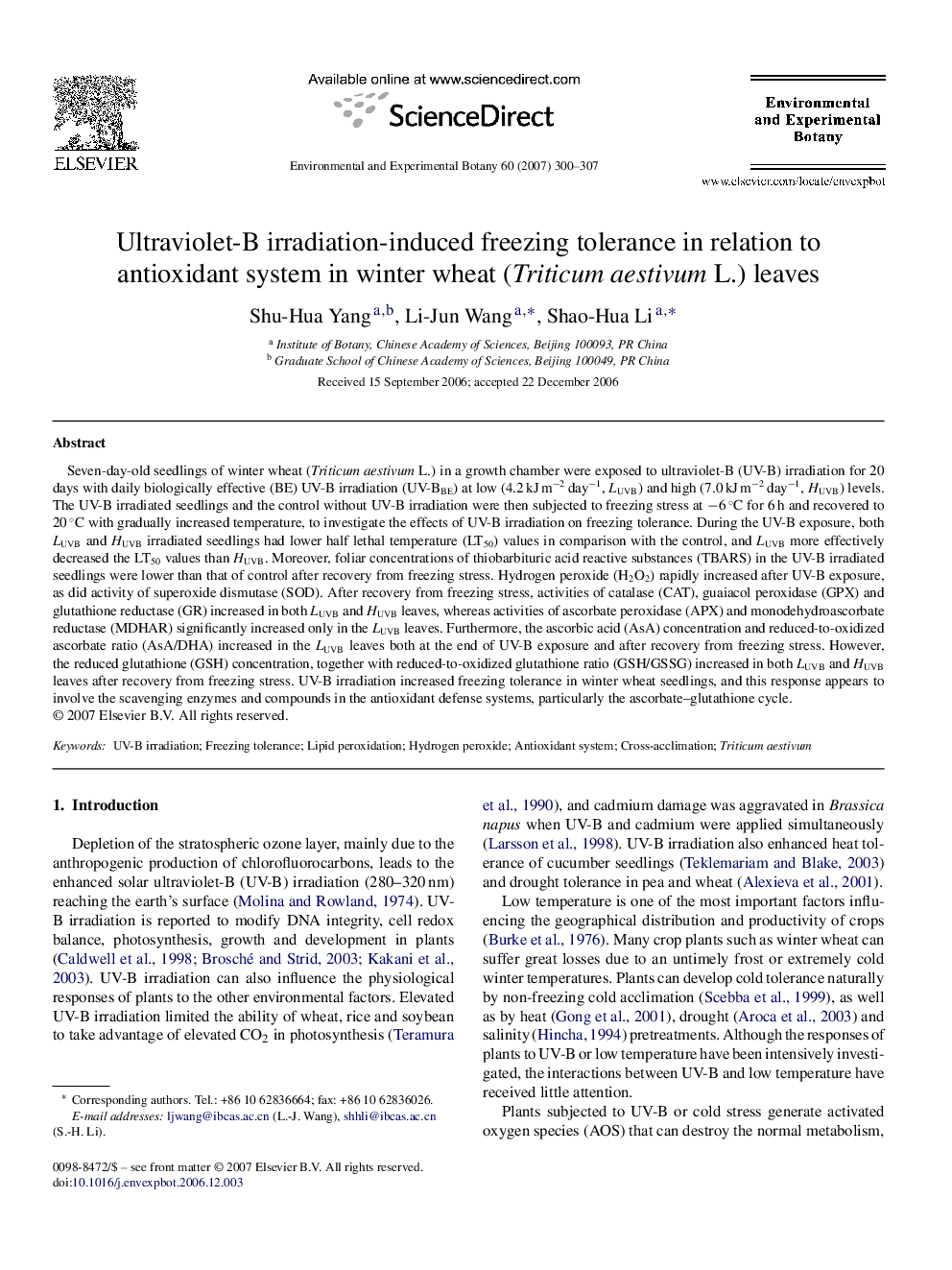| کد مقاله | کد نشریه | سال انتشار | مقاله انگلیسی | نسخه تمام متن |
|---|---|---|---|---|
| 4555457 | 1628108 | 2007 | 8 صفحه PDF | دانلود رایگان |
عنوان انگلیسی مقاله ISI
Ultraviolet-B irradiation-induced freezing tolerance in relation to antioxidant system in winter wheat (Triticum aestivum L.) leaves
دانلود مقاله + سفارش ترجمه
دانلود مقاله ISI انگلیسی
رایگان برای ایرانیان
کلمات کلیدی
موضوعات مرتبط
علوم زیستی و بیوفناوری
علوم کشاورزی و بیولوژیک
بوم شناسی، تکامل، رفتار و سامانه شناسی
پیش نمایش صفحه اول مقاله

چکیده انگلیسی
Seven-day-old seedlings of winter wheat (Triticum aestivum L.) in a growth chamber were exposed to ultraviolet-B (UV-B) irradiation for 20 days with daily biologically effective (BE) UV-B irradiation (UV-BBE) at low (4.2 kJ mâ2 dayâ1, LUVB) and high (7.0 kJ mâ2 dayâ1, HUVB) levels. The UV-B irradiated seedlings and the control without UV-B irradiation were then subjected to freezing stress at â6 °C for 6 h and recovered to 20 °C with gradually increased temperature, to investigate the effects of UV-B irradiation on freezing tolerance. During the UV-B exposure, both LUVB and HUVB irradiated seedlings had lower half lethal temperature (LT50) values in comparison with the control, and LUVB more effectively decreased the LT50 values than HUVB. Moreover, foliar concentrations of thiobarbituric acid reactive substances (TBARS) in the UV-B irradiated seedlings were lower than that of control after recovery from freezing stress. Hydrogen peroxide (H2O2) rapidly increased after UV-B exposure, as did activity of superoxide dismutase (SOD). After recovery from freezing stress, activities of catalase (CAT), guaiacol peroxidase (GPX) and glutathione reductase (GR) increased in both LUVB and HUVB leaves, whereas activities of ascorbate peroxidase (APX) and monodehydroascorbate reductase (MDHAR) significantly increased only in the LUVB leaves. Furthermore, the ascorbic acid (AsA) concentration and reduced-to-oxidized ascorbate ratio (AsA/DHA) increased in the LUVB leaves both at the end of UV-B exposure and after recovery from freezing stress. However, the reduced glutathione (GSH) concentration, together with reduced-to-oxidized glutathione ratio (GSH/GSSG) increased in both LUVB and HUVB leaves after recovery from freezing stress. UV-B irradiation increased freezing tolerance in winter wheat seedlings, and this response appears to involve the scavenging enzymes and compounds in the antioxidant defense systems, particularly the ascorbate-glutathione cycle.
ناشر
Database: Elsevier - ScienceDirect (ساینس دایرکت)
Journal: Environmental and Experimental Botany - Volume 60, Issue 3, July 2007, Pages 300-307
Journal: Environmental and Experimental Botany - Volume 60, Issue 3, July 2007, Pages 300-307
نویسندگان
Shu-Hua Yang, Li-Jun Wang, Shao-Hua Li,